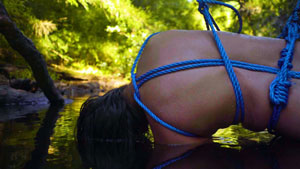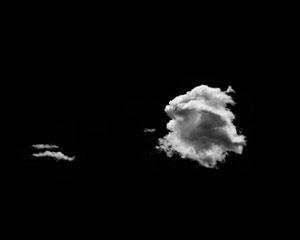The Nature of Desire
John Haberin New York City
Perfect Trouble and Mark Armijo McKnight
Is there something queer about nature? I might not have said so, but art often runs into trouble. Make that "Perfect Trouble: Queering Natureculture" at Wave Hill's Glyndor Gallery.
Wave Hill could be the ultimate hybrid of nature and culture—with its stately galleries, lush grass, meticulously tended botanic gardens, and gorgeous views of the Palisades across the Hudson. Even the best of exhibitions is at most an excuse to return in summer. The eight artists themselves seem happy enough to settle for nature's richness and a bit of art.  They cannot define gender or untangle its meanings. They do not even try to disentangle the natural and cultural aspects of landscape. They show just enough of themselves to make things queer and strange.
They cannot define gender or untangle its meanings. They do not even try to disentangle the natural and cultural aspects of landscape. They show just enough of themselves to make things queer and strange.
Does it still sound unnatural? You may find yourself counting the seconds, but why bother? Mark Armijo McKnight counts them off at the Whitney as no impatient human ever could. Who knows what that will leave a gay artist or the viewer when it is done? McKnight's film makes his gender as hard to pin down as his landscapes, but everything counts.
Present perfect
Wave Hill is more likely to warn of climate change or to celebrate nature than to unsettle its terms. Yet in truth nature in art has always been gendered—and that gender, more often than not, has been female. It contrasts with civilization as men define it and know it. Any number of female nudes have found themselves lying outdoors for the likes of Titian—or falling for its temptations with an apple and a snake. In one tale, Danaë's father did his best to shield her from a lustful Zeus by confining her indoors. Do not be surprised if the god comes in through the window as a golden shower.
This time out, artists need gender just to tell them who they are. Culture plays a still larger role for Katherine Sepúlveda and Roger Ferney-Cortés, in separate shows in the sunroom. Theirs is the immigrant experience, the latter a Colombian's with street carts for popsicles. Sepúlveda fills her Halloween House with a chaos of Catholic collectibles. She just has a little trouble deciding whether to exclude visitors, which she does, or, as wall text has it, to invite them in. But then the galleries will be long closed by Thanksgiving.
"Perfect Trouble" is more welcoming, because who can escape desire? Last year at the New Museum, Pepón Osorio pushed an installation like Sepúlveda's to the edge of a crime scene and the scale of a community. Here the markers are less obvious, but the focus is on sex. That dual impulse, to gender and reticence, helps rescue from the tendentious a motley collection of art. Christopher Udemezue offers hints of people and landscape in close up, in photos and in spooky reds. Others, though, play down a stereotypically gay esthetic.
Sofia Moreno goes so far as to make fun of it. Her self-portrait in colored pencil shares a pink room with grinning demons, and all seem to be having an equally good time. She also adds clay to fabric, for what might be clothing or what it cannot hide. The gendered body may or may not appear for Diana Sofia Lozano, in the thick paint of her Blueberry Dreams, while Erin Johnson takes her video to Huntington Gardens in Pasadena and its scholarly pursuits. One learns only later of Rachel Carson's letters to her female lover. Like Carson herself, they evoke the wonders of nature all the same.
Rachel Youn takes a step back from nature and the human alike, leaving wide open just what to desire. Artificial plants bob rhythmically up and down, and one may remember their loud, mechanical rhythms as much as their orchid purple. Other artists do rely on bare flesh for a touch of nature. Young Joon Kwak speaks of the Aggregate Body, in a wall of fragmentary photos. Seba Calfuqueo unites nature and culture with a Liquid Being, face down in sunlit grass and water. In a photo, she has lost her head but taken in its place a misty mountain peak and clouds.
Who needs earthly desires anyway when you can have goddesses and gods? Two in Indian jewelry share a swing for Pyaari Azaadi, not quite innocent and not quite making love. The artist, born in Bombay, describes herself as BIPOC, or bisexual and a person of color. The others may not be so blatantly hyphenated, but they might wish they were. They are, after all, hyphenating gender, nature, and culture. As Ruben Natal-San Miguel puts it, in portrait photos of the Bronx community up at Wave Hill House, Nature Finds a Way.
Counting the seconds
Dark clouds loom over a full wall at the Whitney, as ominous accompaniment. Will it ever end, and will the darkness? And then at last, after a totally black screen, the shot comes to rest on an otherworldly landscape and a metronome. It is Mark Armijo McKnight's coming to be as a gay male and an American artist. It is also his "Decreation." He just happens to leave something temptingly incomplete along the way.
 McKnight takes his title from Simone Weil, who began as an activist and ended as a mystic. As a mere child in a Jewish family, she spoke out against World War I. Through a lifetime of poor health, she stood up for trade unions and, like Gerda Taro and Robert Capa, the republican cause in the Spanish Civil War. In the end, though, she had a vision of the loss of self before a Christian god. It was as if her entire life had been shot out of the barrel of a gun, never to return. A photo from McKnight could well depict just that.
McKnight takes his title from Simone Weil, who began as an activist and ended as a mystic. As a mere child in a Jewish family, she spoke out against World War I. Through a lifetime of poor health, she stood up for trade unions and, like Gerda Taro and Robert Capa, the republican cause in the Spanish Civil War. In the end, though, she had a vision of the loss of self before a Christian god. It was as if her entire life had been shot out of the barrel of a gun, never to return. A photo from McKnight could well depict just that.
In reality, its puff of smoke belongs to clouds, wispy bright ones, as does a trail of smoke. It evokes Western skies in a great tradition of American art, of Ansel Adams in photography or paintings and drawings by Georgia O'Keeffe. A dreamer might say that it belongs, too, to the promise of an expanding nation—and an activist to its violence against Native Americans. McKnight could well identify with them all. The curators, Drew Sawyer with Nakai Falcón, surround the film with just half a dozen large photographs and two sculptures. They fall somewhere between a single installation, a premature retrospective, and the decreation of the artist's dreams.
Titles speak of The Black Space, matter, sleep, and dreams, and McKnight writes of the "queer refusal of the disinterested gaze." More than one photo shows naked bodies entwined and out of doors. They are all but indiscernible from strangely biomorphic hills—or an animal's corpse in the dried grass and weeds. The photos stick to black and white, the film to sixteen millimeters, as if caught in an embodied world before the digital. Anti-Matter, also a photograph, looks all too material. Even the sculpture, concrete blocks with serious chips at their base, might be coming apart.
The film is in a tradition of lushness and austerity. It is going nowhere fast, like films by Michael Snow or the Empire State Building for Andy Warhol. The relentless ticking of a metronome recalls Minimalism in music and the refusal to make music at all in John Cage. McKnight says that he drew on György Ligeti, the Hungarian-Austrian composer of "micropolyphony." While the film closes in on just one metronome, one can hear many more through speakers high on the facing wall. He swears that one could see them all if only the camera drew back.
Things happen when they happen and no more. The ticking continues, loudly, and comes to an end as abruptly as it began. Circles, incised in concrete and crossed by diagonals, could each belong to a clock face lacking numbers. Like the film, they gesture to passing moments but refuse to tell time. I cannot swear what "Decreation" has to say about mysticism, gender, the environment, or the United States. Still, it speaks loudly, and McKnight can claim the lushness and austerity as his own.

"Perfect Trouble" ran at Wave Hill's Glyndor Gallery through August 11, 2024, Mark Armijo McKnight ran at The Whitney Museum of American Art through January 5, 2025.




